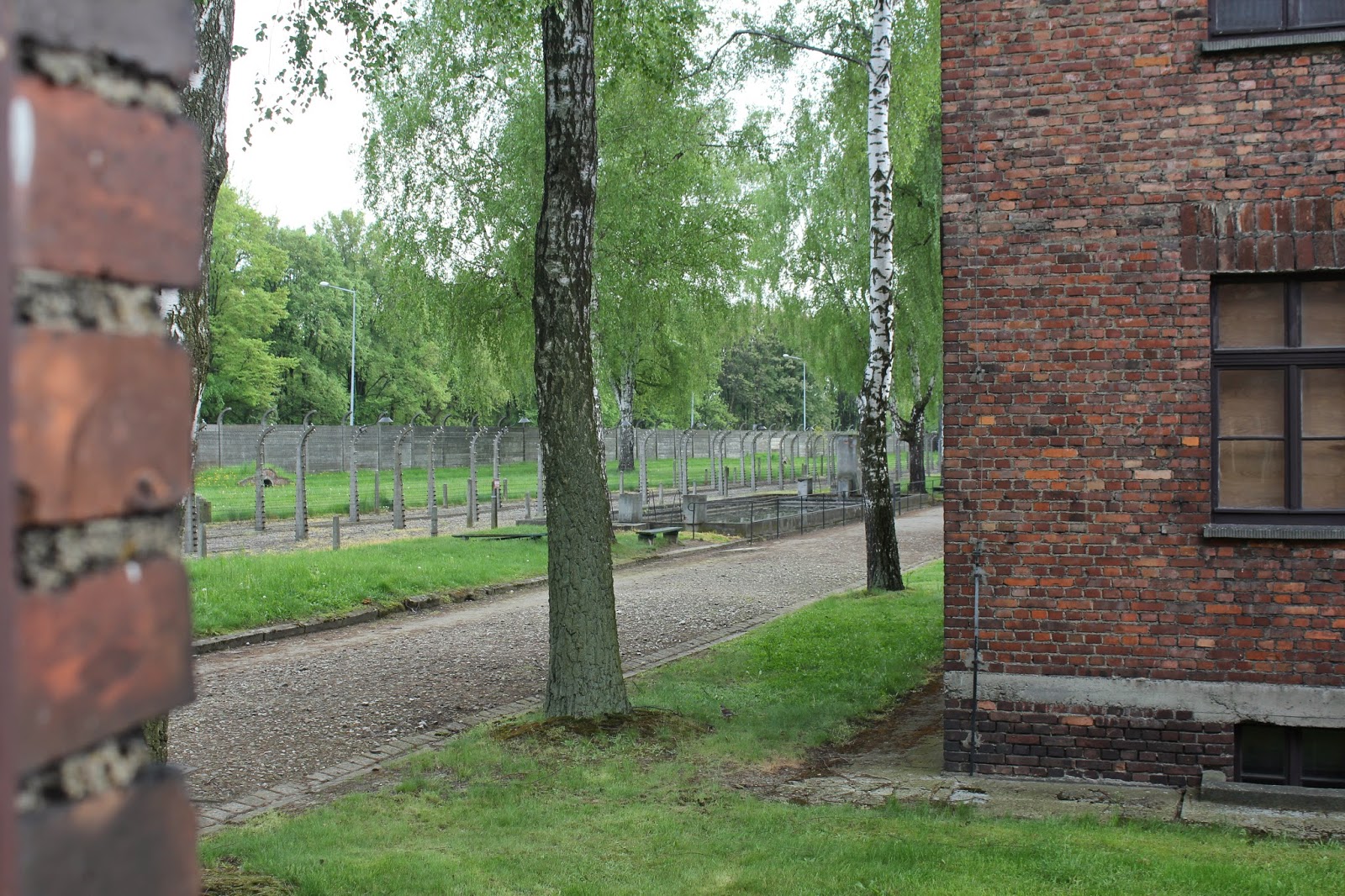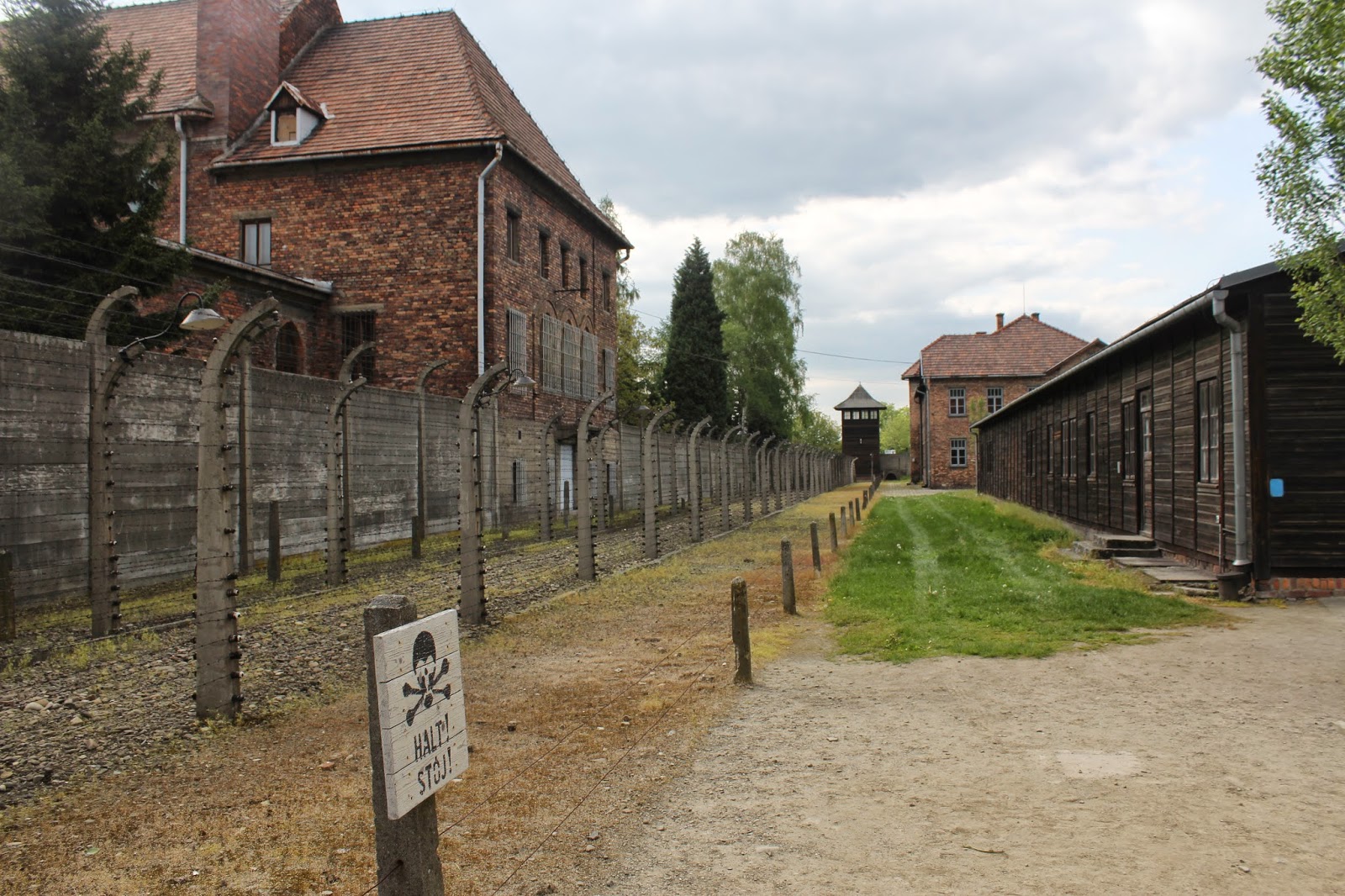I will start off this life changing adventure with my visit to Terezín. Terezín or Theresienstadt was a concentration camp, ghetto, and a prison in an area north of Prague. This was my first concentration camp visit and a definitive eye opener.
The cemetery outside the walls of Terezin where a few of the victims of the camp were given a proper burial. Some headstones contained a date while many simply contained a name.
"Arbeit macht frei" This German slogan meaning "work makes free" was commonly displayed above entrances to concentration camps throughout Europe. That slogan was rarely if ever accurate.
This long corridor was the location for registration of prisoners, followed by being given a uniform, and finally marched through the gate into the prison cells. These cells designed to hold 40 people were often crammed with over 100 people. Poor diet, horrible conditions, and high levels of diseases made survival unrealistic. Any mail that the prisoners would received from family or friends was opened by SS guards and rarely if ever made it to the rightful owner. Any food sent was mixed or cooked and fed to the entire camp. Medicine, cigarettes, and food was all mixed together and served as food. (if you want to call it food)
These barracks were built as an additional living quarters to Terezin by prisoners; over 600 prisoners would remain here at one time. The temperatures in the summer reached well over 100 degrees inside and unbearably cold in the winter. No mattresses, one toilet, and no privacy.
Now for an enjoyable experience? Definitely!
The trip to Kroměříž will always be a great memory. This city was relaxing and enjoyable, while keeping its own identity different from any city I have previously visited.
The view from the top of the tower in the Kroměříž Palace of the Archbishops, which is a UNESCO World Heritage Site.
The palace garden was a unique experience to encounter. This palace garden was massive, extending in every direction from the picture above. This garden contained several lakes, a stream, and its own zoo.....Not a bad place to live.
The next stop in Kroměříž was the highlight of the day and one of my many favorites while visiting Europe. The wine cellars of the Archbishops of Kroměříž. Here we enjoyed a guided tour and a tasting of all natural
high-quality sacramental wines, whose tradition goes back more than 730
years. Wine vats of various sizes scattered the cellar where
the delicious wine matures.
The cellar's temperature and atmosphere are perfect conditions for making and storing this adult grape juice. The temperature varies only a few degrees. The temperature is always between 48 and 51 degrees Fahrenheit. Almost the entire cellar is covered in mold, walls and ceilings included (picture above). Not sure how this stands on a health point but if the wine is happy then I'm happy.
One of the many vats in the cellar. Can anyone guess the amount of wine stored in this vat? 19, 100 liters of wine or 25, 466 bottles.
A quick stop in Ostrava to visit Vítkovice Ironworks was interesting. Over 90 million tons of iron was produced here while the factory was in operation. This industrial park is now toured daily with people from all over the world. Even though I am not an expert on iron ore production, I still enjoyed learning about the aspects and being able to have the opportunity climb the various structures like employees of the factory used to do so.
The replication of the Jewish ghetto in Krakow was one of my favorites during the museum visit. Feeling the rock beneath my feet with a barbwire fence gave me a small sense of how extreme the ghetto was.
Walls on walls of Nazi propaganda scattered throughout the museum.
This simple statement needs no explanation.
Some of the thousands of pieces of metal ware produced by the factory of Oskar Schlindler.
The Wawel Castle in Krakow was another place visited in Poland. During the visit to the castle, we visited the castle armory, the dragon's den, and the estate rooms of the castle.
The visit in Krakow was great. This city is in my top 3 cities visited thus far in Europe. The food was fantastic and the people were extremely friendly. I would love to make a return visit in the near future.
Auschwitz
Usually when visiting a new place, I can feel excitement for this new and upcoming experience. My excitement or desire to visit Auschwitz was non-existent. Upon arrival, I was shocked by the presence of hotels and restaurants right next to Auschwitz I. How people sleep so close to a place where obliteration and eradication of human life occurred? That is one question I may never understand.
The pictures above are the entrance to Auschwitz I. Most people just think of Auschwitz as 1 camp but there were 3 main camps with over 40 smaller satellite camps. The camps are as follows: Auschwitz I, Auschwitz II (Birkneau/Killing Camp), & Auschwitz III or Monowitz-Buna (Labor Camp/Factories). The picture of me smiling did not last long once our tour began. You will see in the upcoming pictures, which are extremely difficult to explain, why a smile is impossible to create.
Locations of people transported to Auschwitz. Many of these people went straight to Auschwitz II to the gas chambers. Upon entering these buildings, my first impression or feeling was the staircases. Warped and worn cement staircases and uneasy to walk on, my first thought was how many people had walked upon these stairs. That was an uneasy experience.
A picture from inside a block at Auschwitz. A look out the window still resembled a prison.
1 can of Zyklon B claimed the lives of 700 people.
Names and descriptions of items taken from people arriving to Auschwitz. They were often told to leave their belongings and they will be able to return later to collect them. These people were never able to return, most went straight to the gas chambers.
Well over 500,000 pairs of shoes......difficult to talk about and even worse to view in person.
Block 11. A prison inside of a prison. In my opinion, this was one of the worst parts of Auschwitz. The cement wall was the execution wall where human lives were taken by the squeeze of a trigger from a German SS official. The slanted posts were a torture methods used when arms were placed behind the back of the particular person and hung by the eye screw by the rope binding the hands. Germans prevented the inmate from touching the ground while being exposed to this torture method. This often resulted in the dislocation of the shoulders and/or broken bones. After this punishment lasting 1 hour, many were sent straight to the gas chamber because if you cannot work you cannot live.
The means of transportation for people taken to Auschwitz.
Inside of Auschwitz II.
After visiting Auschwitz, the experience to difficult to speak of, let alone think about. The memory of Auschwitz will always remain in its own preservation but the interpretation of this place will be forever changing as I continue to learn about my life and the changes the world will experience. I have no desire to ever return here. One Visit Is One Too Many.
Until next time....
Thad
--Always do as the locals do--







































No comments:
Post a Comment